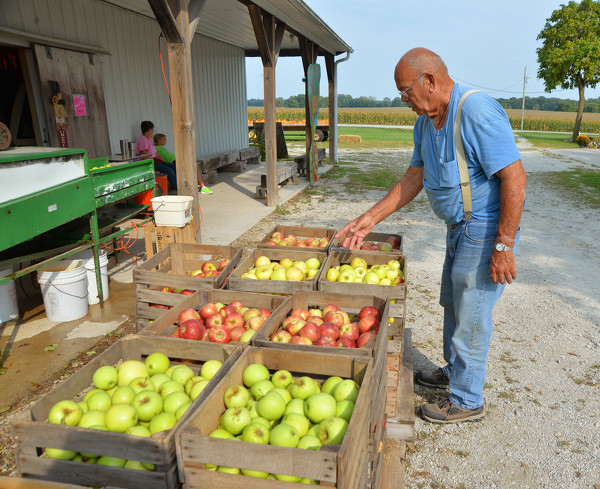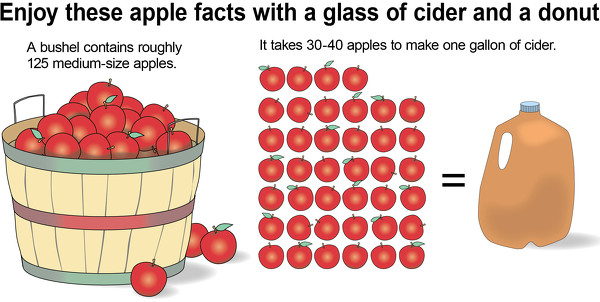Wednesday, October 26th, 2022
Cider Rules
At Christmastime, wassail is king. Lemonade and iced tea are huge in the summer. But no beverage says autumn quite like a glass of apple cider.
By Leslie Gartrell

Photo by Leslie Gartrell/The Daily Standard
Jim Menchhofer, owner of Menchhofer Farms, shows a variety of apples that will be made into apple cider.
COLDWATER - Jim Menchhofer strolled past rows of boxes filled to the brim with apples from his farm's orchard.
The fruit came in a variety of shades of red, green and yellow. The apples were destined for a single purpose: apple cider.
Menchhofer Farms, located at 5679 Wabash Road, has made freshly-pressed apple cider for nearly 20 years, selling around 2,000 gallons of cider each year.
Making apple cider is less complex than one might think. However, it can require some heavy machinery - namely an apple crusher and a hydraulic press.
The story begins, of course, with apples. About one third to half of the apples grown in the Menchhofer Farms orchard are dedicated to cider making, Menchhofer said.
Yet not all apples are created equal, he said.
Take the red delicious apple for example - bright red and beautiful, this apple was designed to look appealing. However, its flavor leaves much to be desired, Menchhofer said.
Sweet varieties such as honeycrisp and fuji are great for cider, but using these varieties alone would make a far too sugary cider.
"Normally I try to have at least five different varieties of apples," he said.

Photo by Leslie Gartrell/The Daily Standard
Golden delicious apples wait to be sanitized.
Depending on what's available in the orchard during the growing season, the farmer said he uses fuji, gala, golden delicious, red delicious and honeycrisp apples to make cider.
The variety of apples make a well-balanced cider that's not too sweet or tart, he said.
It takes 10 pounds of apples to make a single gallon of cider, Menchhofer said. Once the apples have been gathered, the fruit is sanitized with chlorine water to clean away any dirt or bacteria and given a fresh water rinse.
Apples with bruised or undesirable-looking flesh can still be used for cider, Menchhofer said. Staff peel or slice away whatever looks objectionable on the apple before setting them aside.
Whole apples are fed into an apple crusher, including the skin, stem and core. The machine mashes and grinds the fruit until it reaches a consistency similar to applesauce.

Photo by Leslie Gartrell/The Daily Standard
Aaron Sheets, 13, feeds whole apples into an apple crusher before dumping a basketful of apples into the machine.

Photo by Leslie Gartrell/The Daily Standard
Crushed apples are wrapped in fabric and weighed down with blocks to press out the juice.
The crushed apples are wrapped in fabric and transferred to a hydraulic press. The fabric, once a pure white, is stained brown after a few cycles through the hydraulic press due to the apple juice, Menchhofer said.
The bundles of mashed apples are layered between heavy, durable boards on a hydraulic press. The roughly 70 year old hydraulic press can handle about seven layers of crushed apples per press.
Using wooden blocks, the layers of crushed apples and boards are pressed down, squeezing out as much juice as possible. The juice trickles into a 55-gallon holding tank before being measured out into gallons.
The leftover apple crush can be composted or fed to pigs, he said, but noted there aren't many other uses for the scraps.
Menchhofer said staff try to press apple cider at least twice a week, completing the cycle of crushing and pressing cider around six times during each session.
Two nights of pressing apple cider can create approximately 300 gallons of cider each week, he said.

Photo by Leslie Gartrell/The Daily Standard
Menchhofer Farms staff members fill gallon jugs with freshly-pressed juice.
Unlike traditional apple juice, apple cider is unfiltered, unsweetened and unpasteurized, Menchhofer said.
Traditional apple juice is always filtered to remove pulp and sediment from the raw juice, whereas cider is not. As a result, commercial apple juice is typically clear while cider may appear cloudy or opaque.
The cider features no sweeteners, preservatives or additives, which means it is not shelf stable, Menchhofer said. Fresh cider can last about two weeks in the refrigerator, he said.
Those who purchase the farm's cider may notice a buildup of residue at the bottom of the gallon if left to sit for a little while.
Menchhofer said the sediment is nothing to fear - the residue is simply apple particulates that have settled at the bottom of the jug. Customers need only shake the jug to reincorporate it, which has no effect on taste or texture.

Photo by Bill Thornbro/The Daily Standard
Enjoy these apple facts with a glass of cider and a donut.
SOURCES: Ohio State University, Purdue University
Although fresh apple cider does not contain alcohol, it can be left to ferment at room temperature. Over time, the cider can ferment into hard apple cider or apple cider vinegar, Menchhofer said.
"Being fresh pressed, (the cider is) labeled apple juice but it's considered sweet cider because we haven't given the bacteria time to sit and ferment," said staffer Kelly Sheets.
"It'll take two or three days just at room temperature to start fermenting. That's when you'll get a frothy bubble layer on top. If you let it sit in the refrigerator, it might take three weeks (to ferment)," she said.







